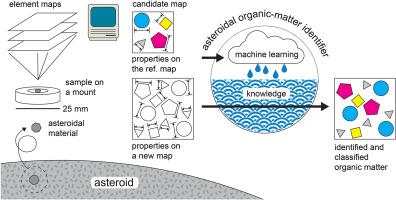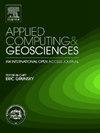在小行星材料中识别μm大小有机物的技术发展:一种使用机器学习的方法
IF 3.2
Q2 COMPUTER SCIENCE, INTERDISCIPLINARY APPLICATIONS
引用次数: 0
摘要
小行星物质中含有有机物(OM),它记录了许多地外环境,从而提供了太阳系过程的记录。OM含有生命起源所必需的化合物。为了了解有机质的起源和演化,需要利用原位技术进行系统的鉴定和详细的观察。虽然以前研究过nm和μm尺寸的OM,但每次研究只研究了给定样品表面的一小部分。本文提出了一种新的工作流程,并将其应用于mm级小行星材料上μm级OM的识别和分类。该工作流程涉及图像处理和机器学习,能够以一种全面、无偏见的方式识别、分类和测量OM的属性。我们发现,通过机器学习分类识别OM比通过聚类更准确。在机器学习的分类方法上,测试了五种算法。随机森林算法在评估的5个精度参数中有4个得分最高,因此选择了随机森林算法。该工作流给出的模态OM丰度与人工识别的丰度一致,表明该工作流可以准确识别1-15 μm大小的OM。OM的大小分布采用幂律分布建模,斜率α值与破碎过程一致。OM的形状用圆度和固体度来量化,给出了正相关关系,表明这些性质密切相关。总的来说,该工作流程能够快速准确地识别许多OM,并获得化学和岩石学信息。这些信息可以帮助进一步的原位技术选择OM,并阐明保存在小行星材料中的OM的起源和演化。本文章由计算机程序翻译,如有差异,请以英文原文为准。

Development of a technique to identify μm-sized organic matter in asteroidal material: An approach using machine learning
Asteroidal materials contain organic matter (OM), which records a number of extraterrestrial environments and thus provides a record of Solar System processes. OM contain essential compounds for the origin of life. To understand the origin and evolution of OM, systematic identification and detailed observation using in-situ techniques is required. While both nm- and μm-sized OM were studied previously, only a small portion of a given sample surface was investigated in each study. Here, a novel workflow was developed and applied to identify and classify μm-sized OM on mm-sized asteroidal materials. The workflow involved image processing and machine learning, enabling a comprehensive and non-biased way of identifying, classifying, and measuring the properties of OM. We found that identifying OM is more accurate by classification with machine learning than by clustering. On the approach of classification with machine learning, five algorithms were tested. The random forest algorithm was selected as it scored the highest in 4 out of 5 accuracy parameters during evaluation. The workflow gave modal OM abundances that were consistent with those identified manually, demonstrating that the workflow can accurately identify 1-15 μm-sized OM. The size distribution of OM was modeled using the power-law distribution, giving slope α values that were consistent with fragmentation processes. The shape of the OM was quantified using circularity and solidity, giving a positive correlation and indicating these properties are closely related. Overall, the workflow enabled identification of many OM quickly and accurately and the obtainment of chemical and petrographic information. Such information can help the selection of OM for further in-situ techniques, and elucidate the origin and evolution of OM preserved in asteroidal materials.
求助全文
通过发布文献求助,成功后即可免费获取论文全文。
去求助
来源期刊

Applied Computing and Geosciences
Computer Science-General Computer Science
CiteScore
5.50
自引率
0.00%
发文量
23
审稿时长
5 weeks
 求助内容:
求助内容: 应助结果提醒方式:
应助结果提醒方式:


